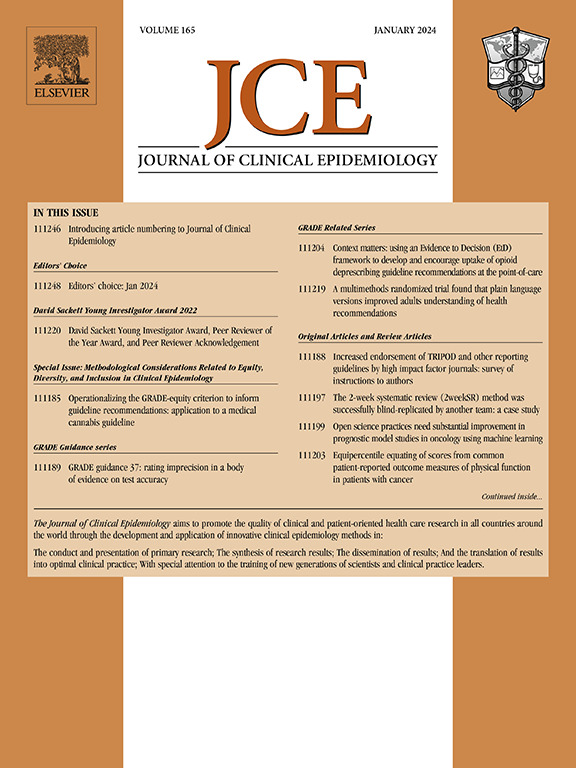A scoping review of the assessment reports of genetic or genomic tests reveals inconsistent consideration of key dimensions of clinical utility
IF 7.3
2区 医学
Q1 HEALTH CARE SCIENCES & SERVICES
引用次数: 0
Abstract
Objectives
Genetic and genomic tests are the cornerstone of personalized preventive approaches. Inconsistency in evaluating their clinical utility is often cited as a reason for their limited implementation in clinical practice. Previous reviews have primarily focused on theoretical frameworks used for clinical utility evaluations of genetic tests, rather than actual assessments and examined dimensions, rather than specific indicators within these dimensions. We aimed to review the dimensions and the specific indicators measured in published assessment reports of genetic or genomic tests.
Study Design and Setting
We conducted a scoping review of assessment reports of genetic and genomic tests used for prevention, searching through PubMed, Web of Science, Scopus, the websites of 20 different organizations, Google, and Google Scholar. From the included assessments, we extracted the reported indicators of clinical utility, compiling a list of disease-specific indicators that detailed their numerator, denominator, and calculation methods. We analyzed the extracted indicators by stratifying them according to ten comprehensive dimensions of clinical utility, the assessment framework used, and the type of indicator (categorized as quantitative, qualitative, reference, or no evidence reported). From these indicators, we then distilled a list of general indicators.
Results
We reviewed 3054 unique references and 12,000 results from gray literature searches, ultimately selecting 57 assessment reports. The reference frameworks used were health technology assessment (HTA) (42%), Evaluation of Genomic Applications in Practice and Prevention (EGAPP) (25%), ACCE (21%), and others (12%). We identified 951 disease-specific indicators. The dimensions most frequently evaluated (ie, had at least one indicator) were analytic validity (60%), clinical validity (79%), clinical efficacy (79%), and economic impact (58%). Only 12 assessments compared health outcomes between tested and untested groups, and fewer than 15% of the assessments addressed equity, acceptability, legitimacy, and personal value.
Conclusion
Our study illustrates that, although dimensions such as equity and acceptability, are significantly emphasized in traditional evaluation frameworks, these are often not considered in the assessments. Additionally, our study has underscored a significant dearth of reported primary evidence concerning the clinical efficacy of these tests.
Plain Language Summary
Genetic and genomic tests analyze a person's genes to predict health risks and guide healthcare decisions, potentially identifying who might benefit from certain treatments or check-ups. However, determining whether these tests are genuinely useful for wide use in health services is complex, because there is no standard way to define “clinical utility” of a genetic test. To understand how these tests are evaluated, we reviewed 57 evaluation reports from high-income countries, most of which focused on cancer-related genetic tests. We found that many evaluations looked mainly at how well a test predicted a condition (validity) and considered some form of effectiveness, yet often failed to measure whether the test truly improved patient health outcomes, such as lowering death rates or enhancing the quality of life. Moreover, factors like patient acceptance, equity, and personal relevance (eg, reducing anxiety) were frequently overlooked. Without including these broader considerations, evaluations risk missing critical evidence that would indicate whether a test is helpful, fair, and worth using. From over 900 unique indicators used to measure clinical utility, we created a simpler list of about 150 general indicators that can guide future evaluations. This consolidated list can help test developers decide which factors to investigate, evaluators determine what to measure, and policymakers identify what might be missing before deciding if a test should be adopted in healthcare. By highlighting the gaps—areas that should be assessed but currently are not—our study encourages a more comprehensive approach to evaluating genetic tests. If we fail to consider issues like equity, patient preferences, and proven health benefits, we risk investing in tests that may do little good or even harm patients. Ultimately, recognizing these shortcomings can lead to better-informed decisions, ensuring that genetic testing is used in ways that truly benefit patients and deliver safer, more personalized, and fairer healthcare for everyone.
求助全文
约1分钟内获得全文
求助全文
来源期刊

Journal of Clinical Epidemiology
医学-公共卫生、环境卫生与职业卫生
CiteScore
12.00
自引率
6.90%
发文量
320
审稿时长
44 days
期刊介绍:
The Journal of Clinical Epidemiology strives to enhance the quality of clinical and patient-oriented healthcare research by advancing and applying innovative methods in conducting, presenting, synthesizing, disseminating, and translating research results into optimal clinical practice. Special emphasis is placed on training new generations of scientists and clinical practice leaders.
 求助内容:
求助内容: 应助结果提醒方式:
应助结果提醒方式:


